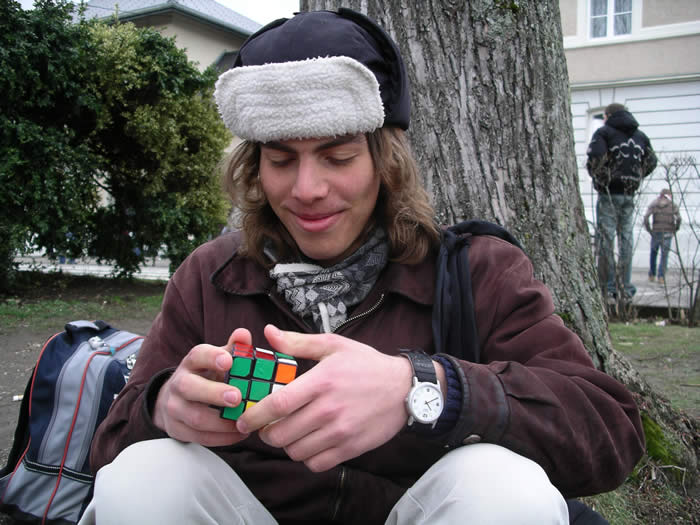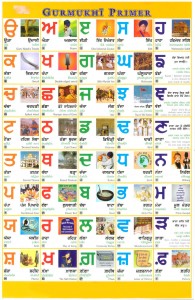
The 300th anniversary of Siri Guru Granth Sahib Ji is being celebrated in an interesting way by dholis in the UK. In 1999, 314 dhol players came together to set a record in the Guinness Book of World Records. This year, in honor of the 300th anniversary, dholfest is trying to set a new record. They’ve registered the event in accordance with Guinness Book of World Records guidelines.
dholfest will be a large outdoor staged event set to break the existing world record of 314 simultaneous dhol players, set in 1999 in Sandwell, West Midlands, UK.
This year we need 500+ players to join us in making this dream come true! [link]
The event is also being dedicated to Ishmeet Singh.
Media XY would like to dedicate this event as a tribute to Ishmeet Singh who was the winner of Star Voice of India. Ishmeet sadly passed away due to drowning in a pool of a resort in Maldives on Tuesday 29 July 2008 aged only 19.
May God give peace and solace to your eternal soul and strength to your loved ones. [link]
Additional info:
The event will take place on Saturday 13th September 2008 in Victoria Square, Birmingham, as part of ArtsFest.
The occasion will mark the celebrations of the 300th Anniversary of the Guru Granth Sahib Ji – as the word Guru. [link]
On Wednesday, August 27, the Delhi High Court sentenced 4 men (Lal Bahadur, Ram Lal, Virender and Surinder Pal Singh) to life in prison, eighteen years after a trial court acquitted them for lack of evidence. The men were charged with rioting, murder, and conspiracy, related to the deaths of Rajinder and Sardool Singh who were burnt alive on November 1, 1984 and their property looted in Sagarpur. The 4 men were also fined Rs. 21,000 each (about $481.43 per person). The High Court stated:
“it is a case where the members of one community were singled out and were murdered and their properties were burnt and looted. Such lawlessness deserved to be sternly dealt with”. [link]
Interestingly, the court found that conspiring to commit a crime was equal to committing the actual crime (I’m assuming that “members of unlawful assembly…in prosecution of the object…” is conspiracy; it’s unclear from the press release whether this is for conspiracy to riot/murder/combination):
“We may observe here that the liability of the members of unlawful assembly who knew that an offence was likely to be committed in prosecution of the object for which they had assembled is equal to those who commit it,” the Bench observed in a judgement on an appeal filed by the state challenging the trial court’s acquittal order. [link] (emphasis added)
 According to a couple of sources, the state appealed the case after the trial court found there wasn’t enough evidence in 1990. If this is true, and not just bad journalism (fabricated facts inserted into the press release), I wish I could congratulate the prosecutors who pursued and won this case.
According to a couple of sources, the state appealed the case after the trial court found there wasn’t enough evidence in 1990. If this is true, and not just bad journalism (fabricated facts inserted into the press release), I wish I could congratulate the prosecutors who pursued and won this case.
A sessions court had earlier on October 31, 1990, acquitted the accused due to lack of evidence. But the state had challenged the judgment in the Delhi high court stating that it have enough evidence to nail the accused persons. [link]
Langa(w)riters have posted on AIDS/HIV infection amongst Sikh women here and here. We have discussed issues around support groups and causes of infection. One of the number one risk factors for contracting HIV/AIDS for Punjabi Sikh women is marriage. Many women are infected by their husbands who are intravenous drug addicts and/or clients of prostitutes. Not only are these women’s lives reaped with more havoc at no fault of their own, but there is also an insurmountable amount of stigma these women endure.
This past week, a Sikh woman, Kiranjit Kaur, stood up with tremendous strength and bravery to help combat this stigma. She become the poster-woman for people living with HIV/AIDS in Malaysia. At the age of 35, Kaur has decided to put her face to this disease because “I am here to help the ‘positive’ community and empower them and tell them they are not alone.”
Kiranjit Kaur contracted HIV in 1996 through her husband who was a former drug addict and has since passed away.
After contracting the disease she began working full-time with the Asian Pacific Council on AIDS Services as an advocate for other HIV/AIDS patients.
 Once again, Indian-Americans have been unwillingly thrust into the heart of a contentious American political battle. For those of you who don’t remember, in 2006, incumbent Senator George Allen singled out and subsequently called an Indian-American, S.R. Sidarth, “macaca” while on the campaign trail. See video here. As The Washington Post’s national political reporter noted, Allen’s use of that slur was a “turning point” in his failed reelection bid, and became “an everlasting part of the political landscape.”
Once again, Indian-Americans have been unwillingly thrust into the heart of a contentious American political battle. For those of you who don’t remember, in 2006, incumbent Senator George Allen singled out and subsequently called an Indian-American, S.R. Sidarth, “macaca” while on the campaign trail. See video here. As The Washington Post’s national political reporter noted, Allen’s use of that slur was a “turning point” in his failed reelection bid, and became “an everlasting part of the political landscape.”
Just a few days ago, presumptive Democratic nominee Barack Obama selected fellow Senator Joe Biden to serve as his running mate. In 2006, Senator Biden said, “In Delaware, the largest growth of population is Indian-Americans, moving from India. You cannot go to a 7-Eleven or a Dunkin’ Donuts unless you have a slight Indian accent.” See video here.
Senator Obama’s decision has generated renewed interest in the 7-Eleven gaffe. See, e.g., here and here. The question is, should we care? In this post, I argue “yes.”
A few days ago Sikhnet News posted a story about the Dastarbandi/Pagri di Rasam/Turban Tying Ceremony of Harmanas Singh, a 16 year old young man in California. 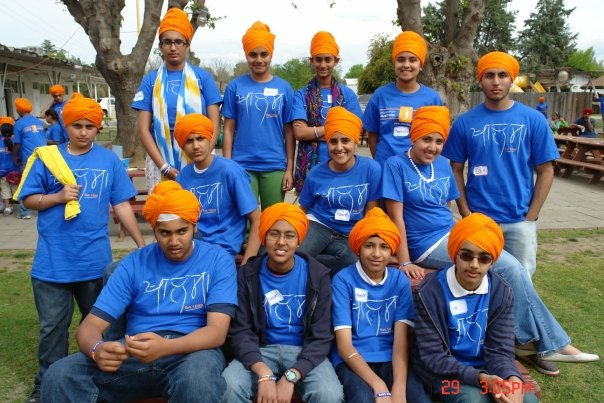 While the story gave only a brief explanation for the ceremony it got me thinking about the significance of the ceremony in the Sikh community in general: why we perform the ceremony, how wide spread it is, and how it pertains today to Sikh women.
While the story gave only a brief explanation for the ceremony it got me thinking about the significance of the ceremony in the Sikh community in general: why we perform the ceremony, how wide spread it is, and how it pertains today to Sikh women.
A couple of websites describe the ceremony like this:
People who have lived in India would know the turban tying ceremony known as Rasam Pagri (Turban Tying Ceremony). This ceremony takes place once a man passes away and his oldest son takes over the family responsibilities by tying turban in front of a large gathering. It signifies that now he has shouldered the responsibility of his father and he is the head of the family. [Source]
The explanation is a bit off –because the ceremony seems more for the passing of personal rather than family responsibility. While there may have been a time when the ceremony signified the passage of family leadership – I think in the Sikh faith the ceremony has come to signify the shouldering of personal responsibility for young Sikhs. The dastarbandi ceremony represents something different for Sikhs – it is as Guru Gobind Singh intended it – a stamp of identity for Sikhs and the responsibilities that being a Sikh entail.
From 7-Elevens to liquor and 99 cents stores, many Panjabi Sikh immigrants build a life for themselves as store workers. Working at these locations gives them a start in America, while engaging with its harsh realities. Regardless of educational background or the pind/shari divide, Panjabi Sikh immigrants work long hours into the night seven days of week trying to build a stable economic future for them and their families. On August 04, 2008, Inderjit Singh Jassal at the age of 62, was one of these Panjabi Sikh immigrants, who was murdered at a 7-11 store during his usual 13-hour shift in Phoenix, Arizona. Jassal had moved to the US nearly 20 years ago, while his wife and two adult children remained in India.
SALDEF reports that:
Mr. Jassal was working at a 7-11 store in West Phoenix when a black male, later identified as 27 year-old Jermaine Canada, walked in with his two children, aged 2 and 6. According to the surveillance video, the two individuals had a short conversation, at the end of which Mr. Canada pulled a concealed firearm from his shirt and fatally shot Mr. Jassal.
The most ironic aspect of this case is that no motive as been found. According to surveillance video there was no angry exchange between Jassal and Canada and nothing was stolen by the murderer.
SALDEF believes that this killing was nothing other than “… a heinous crime motivated by hate”.
According to one of Canada’s relatives, he had a history of drug abuse and mental illness. At the time of the killing, he was under supervised release following 2 years in prison for violating his probation, for a prior dug conviction, with a weapons charge.
Currently, Tajinder Singh Jassal, a nephew of Inderjit Singh Jassal and co-worker, is working to get immigration visas for Inderjit’s wife and children. He is considering sending an appeal letter to Arizona Senator John McCain’s Office for assistance with the visas because “The family is suffering right now. They want to see their father’s face.”
I don’t really know what to make of this, so I won’t even comment. I’ll just let you form your own opinions.
Paramvir Singh Chattwal, of central Hounslow, who claims to be the world’s only Sikh rodeo star after taking up the sport while living in Texas has hung up his spurs for now to track down information about his decorated forefather, who he believes died in or around [Hounslow]. …Paramvir has already spent years researching the life of Risaldar Major Sher Singh Sirdar Bahadoor, who was an original member of the Punjab Frontier Force, formed in 1849. [link]
I’m more interested in Paramvir’s cowboy-ness, than his hunt for his great great grandfather’s legacy, though Paramvir’s view of his ancestor is a bit twisted. Paramvir seems to be equally proud of his cowboy activities, as his grandfather’s fighting for the British in 1857, against his fellow Indians, and also escorting the Kohinoor to become part of the British treasury.
fellow Indians, and also escorting the Kohinoor to become part of the British treasury.
But Paramvir believes [his ancestor] earned his peers’ respect by escorting theKoh-i-noor diamond, then the largest in the world, on a perilous mission across India to Calcutta before it became part of the British Crown Jewels in 1877. “I couldn’t believe he’d been breaking social barriers in 1887 by mixing with the British aristocracy and five generations later I’m doing the same by taking up rodeo,” said Paramvir. (emphasis added) [link]
I’m not trying to promote a tribal mentality (not that that’s a bad thing). But, since when is “mixing with aristocracy” breaking a social barrier?? Slaves “mixed” with their slave owners. Prisoners “mix” with the guards that keep them locked up. Paramvir, you’re confirming my suspicion that all cowboys are stupid, and I really don’t like to generalize. (Ok, one comment.) I hope this article has misquoted you.
Over a year ago, Ajmer Singh Hothi was found shot dead inside a semi-truck that he had just bought and was still making payments on. Only a day before, he had changed his phone number and gotten a restraining order against his ex-girlfriend and her father. [link]
 More information surrounding the case has recently became available since 553 pages of court records from a grand jury hearing have become public.
More information surrounding the case has recently became available since 553 pages of court records from a grand jury hearing have become public.
A prosecutor accuses Gurparkash Khalsa of being driven by humiliation over his daughter’s soiled reputation to the point of ambushing Hothi in a big rig parked east of Stockton. The 56-year-old now sits in a jail cell charged with capital murder… Details of the case recently became public when San Joaquin County Superior Court Judge Charlotte Orcutt unsealed the 553-page transcripts of a four-day grand jury hearing that ended with Khalsa’s April 25 indictment. He was arrested hours later. [link]
The events that led to Ajmer’s death began with a relationship between Hothi and Khalsa’s daughter.
It began in November 2004, when a secret romance sparked between Hothi and Khalsa’s daughter, Kiranjot Pannu, then age 17. The lovers kept it quiet because Hothi was a lowly trucker, while her father owned Pacific Coast Intermodal in French Camp. Hothi’s father, also a trucker, once worked for Khalsa and feared him, according to Hothi’s sister, Kiranjit Hothi, who testified before the grand jury. [link]
Khalsa forbade the romance and Hothi’s parents sent Ajmer to India for an arranged marriage. But then Khalsa heard rumors that Hothi had gotten his daughter pregnant, and that she’d had an abortion. The angry father then demanded that Hothi marry his daughter. He followed Ajmer to India and tried to have him divorced. It seems that he was unsuccessful, and word of his attempt traveled back to Stockton where Khalsa felt humiliated in the eyes of the community. [link]
I remember going to Nagar Kirtans and being awed by those doing Gatka (i.e. Sikh martial arts)! Their “performances” were eye-catching with action, discipline, determination, and spirituality. Watching Gatka helped me connect with Sikh history at a time when there were little resources around me to learn about Sikhi. This martial art gave me some insight into the concept of a “saint-solider” – one who exemplifies Miri/Piri (spiritual/temporal power). I got to see how a saint-solider physically fought to defend Sikhi.
Lately, I have heard people ask, “Is Gatka a “performance” or a “martial art”? I think the “performance” part of the question comes from those who think Gatka is being done more to please crowds than spiritually connect with Sikhi. Also, some think Gatka techniques are being compromised in order for it to be more “safe” for crowd performances? I personally think, Gatka is both a performance and a marital art, but that does not mean spirituality or technique has to be compromised. What do others think?
A recent BBC show on Gatka addressed how it is becoming a way for Diasporic youth to connect to their Sikh heritage, while focusing on physical fitness. It also touches on non-Sikhs participating in Gatka. Let us know what you think!
p.s. I have always found it empowering to see Sikh girls participating in Gatka, even though I rarely see women on Gurdwara management committees!
The Sikh Research Institute (SikhRI) reported today that Arpinder Kaur, 28, of San Antonio, Texas has become the first turbaned pilot hired by a commercial airline in the United States. As a Sikhni, she has helped pave the way for both Sikh men and women who wear a dastaar/turban to fulfill their passion for flying. No longer does flying just have to be an extra-curricular activity for these Sikhs, but it can also be an every-day job!
States. As a Sikhni, she has helped pave the way for both Sikh men and women who wear a dastaar/turban to fulfill their passion for flying. No longer does flying just have to be an extra-curricular activity for these Sikhs, but it can also be an every-day job!
In March 2008, after resolving the issue of wearing her dastaar on-the-job, with the help of the Sikh Coalition, Arpinder Kaur was officially hired by American Airlines Corporation (AMR) as a First Officer. She filed her grievance for accommodation of her religious article of faith based on American Airlines’ allowance of “regulation approved hats”. An agreement was reached that is consistent with state and federal anti-discrimination law. In June 2008 she finished her pilot training program and is now flying Embraer Jets for American Eagle, a regional airline that is part of AMR based out of the Dallas-Fort Worth International Airport.
When Arpinder Kaur was asked why she chose to do this, she said:
“Two of the reasons I did this were: first, my love of flying and, second, to set a precedent for the community so they know you can be in your Sikh appearance and do anything out there; so that my younger brothers and sisters [the rising generation] will pursue their passions while practicing their Sikh faith.”
Her passion for flying first started when at the age of 15 she got to sit in the cockpit of an airplane when moving from Panjab. Despite having a degree in Information Systems and her mother’s belief that it was too dangerous for a girl to be a pilot, Kaur has chosen to follow her passion; while using it as a means for supporting her family. Kaur said it was the love and support of her husband, Pritpal Singh that pushed her forward on the path toward becoming a pilot. Kulbir Singh Sandhu, captain with AMR mentored her throughout her aviation career. From 2003 to 2005 Kaur was trained by Jesse Sherwood in Kansas. With the help of these individuals and others along with her own perseverance and determination, Kaur and American Airlines have shown that accommodation and not assimilation is the way to harness the strength of diversity in America.
Harinder Singh, executive director of the Sikh Research Institute (SikhRI) in San Antonio, Texas said, “This is a great day for the Sikhs in America. Religious accommodation, not assimilation, is what the founders of this great nation envisioned and we are thrilled American Airlines celebrates the rich religious and cultural diversity of all American populations.”
Here is a short film on Arpinder Kaur and “piloting”:
Is your mom “chapter president” or a “member” of the local Sikh women’s Sukhmani Sahib club? Many Sikh women (generally those with Auntie status) are commendably coming together to form small groups who go to each other’s homes about once a month to do Sukhmani Sahib da paat to help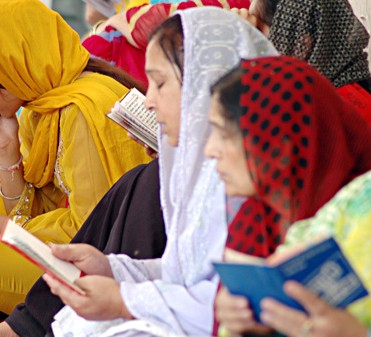 bring/remember peace. Sometimes there is a specific issue a woman’s family is encountering and at other times it just for general familial peace. Thus, our mothers and aunties get to socialize about their everyday lives and connect spiritually through sangat and paat! One of the many things we could learn from them about practicing Sikhi!
bring/remember peace. Sometimes there is a specific issue a woman’s family is encountering and at other times it just for general familial peace. Thus, our mothers and aunties get to socialize about their everyday lives and connect spiritually through sangat and paat! One of the many things we could learn from them about practicing Sikhi!
As International Day of Peace approaches on September 21st, these groups of Sikh women are being asked to come together to recite Sukhmani Sahib da paat. Sukhmani can be defined as counselor of peace or peace of mind with sukh meaning “peace” and mani meaning “mind”, “heart” or “jewel”. The entire paat/poem is known as the “jewel of peace” or “song of peace”. So if your mom belongs to one of these groups or is interested in joining/creating one, please let her know about this day of observance! Now she can do paat to help bring/remember peace in the world along with your well-being!
p.s. It’s always interesting about how many Sikh women are the focal points for spirituality in homes … but that’s another post! 
We’ve occasionally, briefly discussed the current French ban in public schools on articles of faith. Recently, the Sikh Coalition invited high school students from all over the world to submit entries into their Diversity Essay Contest on “The Role of Freedom of Religion in the context of Contemporary Society.”
Students were asked to take one of the following two sides on the French Parliament’s ban on conspicuous “religious” articles of faith from public schools:
- If you favor the ban: While engaging with issues faced by communities impacted by the ban, please discuss how France’s conception of secularism (laïcité) can be used to shed light on the ban.
If you oppose the ban: What makes you oppose it? Please outline a strategy through which the international community may be mobilized to force France to repeal the ban.[link]
The first place winner was Casey Friedman, from Alameda, CA whose essay can be viewed here. An excerpt from this winning essay:
“Although Article 10 of the high-minded Declaration of the Rights of Man and the Citizen states explicitly, “No one should be disturbed on account of his opinions, even religious,” and although the Constitution of the Fifth French Republic recognizes the Déclaration as fundamental law (“La Déclaration”), France today finds itself uncomfortably pulled in every possible direction by the forces of religion, popular will, secularism, and natural right.” [link]
This competition seems like a great way to engage youth both in and outside our community in a conversation on freedom of religion.
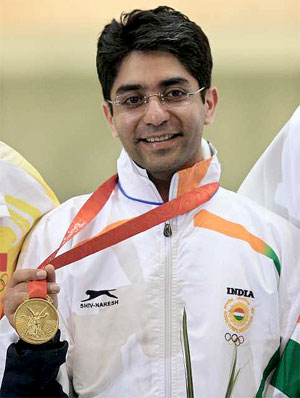 Today Abhinav Bindra won the first individual gold medal ever claimed by any Indian Olympian. He competed in and won the 10M air rifle event this morning in Beijing. We originally posted about him a few days ago here.
Today Abhinav Bindra won the first individual gold medal ever claimed by any Indian Olympian. He competed in and won the 10M air rifle event this morning in Beijing. We originally posted about him a few days ago here.
Abhivan hails from Chandigarh, Punjab and is the son of Dr. A.S. Bindra and Babli Bindra. Abhivan has been training since childhood as a shooter and is a holder of the Khel Ratan Award, India’s highest athletic honor. This is his second time at the Olympics.
His family had gathered at the Sector 8 Gurdwara in the three days preceding his competition for an Akhand patth sahib thanking Waheguru for his success and praying for a win. After hearing that his son had won the gold, Dr. A.S. Bindra proclaimed:
My son has proved that ‘Singh is King’ in a real sense. He has brought laurels for the whole Sikh community and for the whole nation…
——-
As an aside – for those of you wondering, as I was, what his name means – it means “quite new”
Also just found a link to Abhinav’s personal blog
Langa(w)riters have posted in the past on issues surrounding the preservation of the Panjabi language here, here, and here. Be it anywhere from Panjab to North America, the preservation of the Panjabi language is intimately tied to the preservation of a Panjabi and Sikh heritage. For example, in a recent article on Live Oaks High School offering Panjabi courses, Mohinder Singh Ghag, director of Live Oaks Schools Foundation stated:
“The language is the only reason we have a link to our ancestors.”
Thus, the discussion around solutions has understandably centered around learning Panjabi in homes, gurdwaras, high schools and universities. I personally think having these learning opportunities available at all these different sites is a much-needed step towards maintaining the Panjabi language. I have always found the process of getting Panjabi classes taught in high schools particularly interesting because of how they require engaging the community, the reasons for creating them, and how they are incorporated into the public K-12 educational system.
For example, commendably in Live Oaks, California (located about 10 miles north of Yuba City, California):
Punjabi community members knocked on doors and made announcements in temples to get teenagers to sign a petition expressing interest in a Punjabi language class at Live Oak High School.
About 25 students signed-up.
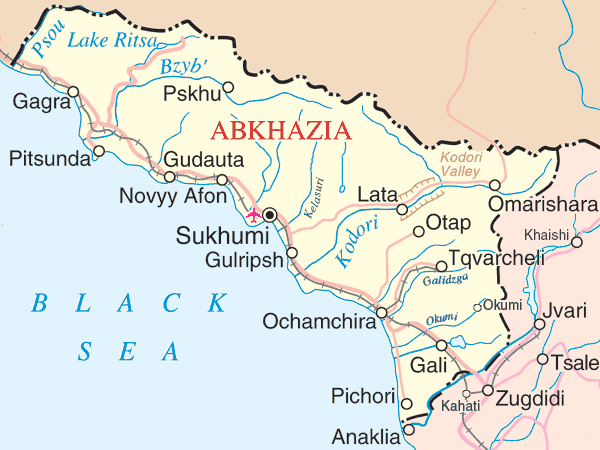
Like many, my family and I watched the opening ceremonies of the Olympics last night. In the middle of the parade of nations, the commentators off-handedly remarked that the country of Georgia had just been invaded by Russia, over an escalated territorial dispute (note that this region of the former-USSR has been the stage for other battles over nation and territory; the Chechen Republic is a close neighbor of Georgia on its northern border). Russia has launched a full military campaign involving air and ground troops and targeting the Georgian city of Gori (not located in the disputed region); this has already resulted in civilian injuries and deaths. Georgia has also asked for U.S. assistance in airlifting their troops from Iraq back home.
I can’t confess to know the entire back story; I’m terribly unfamiliar with Abkhazia and had no idea that hostilities had been mounting (beyond the “normal” level) between Georgia and Russia. In reading the NYT coverage this morning, I stumbled across this statement:
Georgian officials said their only way out of the conflict was for the United States to step in, but with American military intervention unlikely, they were hoping for the West to exert diplomatic pressure to stop the Russian attacks.
As familiar as I am with realpolitik, I was alarmed that the only “hope” for stabilization or a stop to the assault was U.S. intervention. This made me reflect on the concept of witness: in times of war, what does it mean to bear witness to an atrocity, but fail to intervene? In times of “peace,” what does it mean to acknowledge that human rights abuses take place, but fail to challenge a system that prioritizes compliance? What does our faith require in these moments? In these moments, what is justice, and what is our duty as a faith community that values justice and freedom?
Jathedar of the Akal Takht, Giani Joginder Singh Vedanti, resigned yesterday without providing any real reason for the step down. From reports it seems that the Jathedar was asked to resigned late Monday night  after some SGPC execs visited him at home – the apparent reason: differences of opinion with the Shromini Akali Dal (lead by Badal) and the SGPC (lead by Makkar). In an attempt to cover up the transparently obvious removal, the SGPC president, Avtar Singh Makkar attributed the resignation to Vedanti’s ill health. However, most sources reported something more along these lines:
after some SGPC execs visited him at home – the apparent reason: differences of opinion with the Shromini Akali Dal (lead by Badal) and the SGPC (lead by Makkar). In an attempt to cover up the transparently obvious removal, the SGPC president, Avtar Singh Makkar attributed the resignation to Vedanti’s ill health. However, most sources reported something more along these lines:
It is understood that Vedanti’s increasing proximity with hard liner Sikh organizations on the issue of Dera Sacha Sauda and his public opinion to vote for Sikh Prime Minister Dr. Manmohan Singh during UPA government’s trust vote on July 22 last were key factors that compelled SGPC to pack up Vedanti. The reports said that Punjab Chief Minister Parkash Singh Badal had told Vedanti to quit else he will be expelled.
After reading about Jathedar Vedanti removal and the circumstances, (like many others) I am a bit confused and disturbed with the recent trend – Jathedar Vedanti’s removal is not a first:
The removal of Bhai Jasbir Singh Rode as the Akal Takht Jathedar started the trend of sacking Jathedars. Previously, a Jathedar either resigned or died in office.
Bhai Ranjit Singh, the daring Jathedar of Akal Takht was sacked on April 28,1998 and SGPC installed Giani Puran Singh as the new Jathedar on February 15,1999. Vedanti was appointed as acting Jathedar of Akal Takht on March 28, 2000 after the SGPC then led by Bibi Jagir Kaur blamed Giani Puran Singh of violating the maryada (Sikh code of conduct) and sacked him.
I think what makes this most unsettling is the fact that the Jathedar of the Akal Takht is supposed to be given a certain degree of credibility and authority. The Jathedar is a Sikh leader; someone who represents our interests, is our ambassador, and serves as a guide to Sikhs worldwide. I’m not giving him/her Papal status by any means, but the Jathedar’s position is an executive role within the Panth and removal at the whim and fancy of often corrupt officials in the SGPC or the SAD illegitimates any credibility the position once held. The fact that the last four Jathedars have been “removed” by the SGPC/SAD & Co. says a great deal about the way our Panth is run…little of which can be construed in a positive light.
In a recent post, Camille asked important questions around growing Sikh female leadership/representation, rather than just “managing” it. At the heart of leadership in any organization is decision-making. A critical component of growing Sikh female-leadership/representation is giving access to decision-making spaces that are commonly occupied by Sikh men and incorporating female perspectives into decision-making. Thus, you will see the strongest battles for gender equity in Sikh organizations tend to be fought around decision-making power. A recent example of such a battle was at a Gurdwara in Bristol, U.K. where two factions were fighting over allowing women to take part in Gurdwara elections. Women were demanding the right to vote while also running for committee-member seats. This past Sunday during Gurdwara management-committee elections, both factions broke out into a riot over allowing 79 women to vote past the registration deadline.
According to the Daily Mail:
Six riot vans were dispatched to close the road in Fishponds, Bristol, and one man was arrested and cautioned for a public order offence during the seven-hour stand-off.
Voting finally finished at 4pm and resulted in three women being voted onto the management committee for the first time in the temple’s history.
The trigger for the riot was when one man frustrated by the situation started trouble inside the Gurdwara that spilled out onto the street where “women were blocking his car and trying to push it over while he was still inside clinging to the steering wheel”.
An elderly women at the site reported “… a crowd of mainly women and children stood on one side of the road and men on the other. They were fronting each other up and shouting abuse across the road. The women were screaming ‘we’re not going anywhere’.
In case you’ve missed the front page of every major newspaper in the past few days, nearly 150 people died in a stampede in the Naina Devi temple in Himachal Pradesh. (As great of a tragedy as this is, I’m not sure why it’s front page on American newspapers, considering that incidents of this nature occur all too often in India.)
Religious pilgrims were trampled to death on a hillside on Sunday morning, after rumors of a
landslide sparked a stampede, local officials said. Thousands of Hindu pilgrims traveled to Naina Devi, a hilltop temple in the state of Himachal Pradesh, on Sunday during a festival celebrating the Hindu mother goddess. Heavy rains in the morning led many to take cover in a shelter, local officials said. Some eyewitnesses said visitors on their way down the hill claimed large stones began sliding down the hillside, leading to panic in the crowd below, while others heard rumors of a bomb. [link]
In addition to the stampede, deaths were caused by lack of required medical care.
Local clinics were overwhelmed by the injuries and ran short of medicines and supplies. [link]
During this time of tragedy, the Sikh community came together through kar sewa to assist with the bodies when the government failed to arrange transportation for the bodies. Kar sewaks also organized and served langar and cha to the grieving relatives of the deceased who were camping at the evacuation site.
 I was in London last week and stopped off in Hounslow, Ealing and Southall to just walk about and visit family. In the past 50 years, Southall has become a huge pass-through and historic cultural and political center for Punjabis, especially Indian and Sikh Punjabis, in London and the greater UK. I visited the neighborhood a few years ago, and I looked forward to returning.
I was in London last week and stopped off in Hounslow, Ealing and Southall to just walk about and visit family. In the past 50 years, Southall has become a huge pass-through and historic cultural and political center for Punjabis, especially Indian and Sikh Punjabis, in London and the greater UK. I visited the neighborhood a few years ago, and I looked forward to returning.
I was a little surprised to see that the neighborhood had changed. In addition to taking on an ever-growing refugee population from Somalia, there seemed to be a growing Sikh Punjabi underclass. Southall, historically, has been populated by working- and middle-class desis, and with that comes a variety of concerns around resource availability, support, language and social services, etc. Multi-family or multi-worker flats and apartments are not uncommon, but I was surprised by the increased concentration of subpar worker housing. Instead of the more prevalent norm of helping out new immigrants by sheltering them and helping them acclimate to London, there seemed to be a small (but growing) formation of Punjabi-run slum housing, similar to the exploitative workers’ ghettoes and communities of New York in the early- to mid-1900s.
I was really distressed by this development; Southall has amazing local institutions that are nationally and internationally reknowned for their civic engagement and dedication. In many ways, it is the face of the UK Sikh community, for better or worse. I’m not naive; I know that our community has deep and complicated internal issues and challenges. How do we begin to address these basic issues of justice, their connection to Sikhi, and what this means for the reputation and behavior of the community as a body? I don’t think we should dictate or micro-manage people’s behavior, but I do think it’s important to have begin to create ways to mediate conversations and norms/attitudes around how Sikh ethics translate into practice.
I recently ran across Relocating Gender in Sikh History by Doris R. Jakobsh who is now an Assistant Professor of Religion at the University of Waterloo. I’m not a scholar of either Sikh history (and Jakobsh shouldn’t be considered one until she can read and understand Gurbani), and the ideas presented below are just fodder for discussion – not being put forth as any authoritative data.
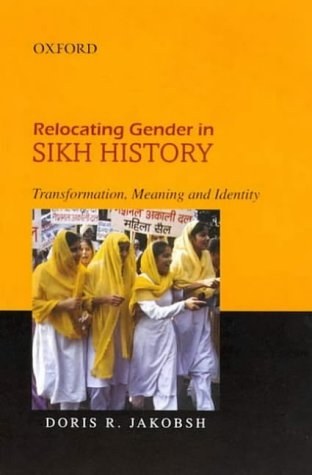 The framework she uses notes the difference between the prescribed Sikh belief of equality amongst Sikh women and men, and what is actually practiced within the Sikh community, claiming that gender has generally been dealt with in 1 of 4 ways: silence, negation, accommodation, idealization.
The framework she uses notes the difference between the prescribed Sikh belief of equality amongst Sikh women and men, and what is actually practiced within the Sikh community, claiming that gender has generally been dealt with in 1 of 4 ways: silence, negation, accommodation, idealization.
One of the biggest problems that I noted when reading the book is her use of English translations of Gurbani for her basis of analysis. We’ve discussed before the problems that we, as Sikh practitioners, experience in understanding Gurbani, due to language barriers. Yet, she bases her research on translations that are subject to the same barriers and misunderstandings. Because of this language barrier, her reading of Gurbani is way off. Despite this, I do believe her feminist analysis of historical writing warrants discussion.
1- Silence: Jakobsh claims that silence is the guiding principle regarding women in Sikh history. Traditional recording of history focuses on politics and economics, realms that women have not been well represented. Women have also not been the authors of their own history, and so the specific questions asked have been those of interest to male historians.


